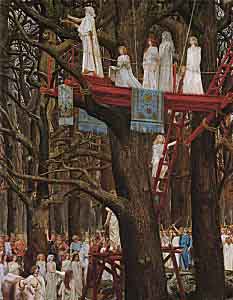 Originally published in 1911, and now available in Dover paperback, "Religion of the Ancient Celts," is a well written and engaging scholarly work.
Originally published in 1911, and now available in Dover paperback, "Religion of the Ancient Celts," is a well written and engaging scholarly work.Well worth its price, the work is suitable to the general public, while still valuable to those interested in the Celts from an historic, linguistic, mythological or ethnological standpoint. MacCulloch covers his subject matter clearly and thoroughly (referencing such things as parallels with Greek mythology and Sumerian religion) and writes in a style that will satisfy the expert without mystifying or losing the attention of the amateur.
The main text is 390 pp, is fully referenced in footnotes, and is fully indexed. Chapter titles include: Gods of Gaul - The Irish Cycle - Tuatha De Danaan - Gods of the Brythons - Cuchulainn Cycle - Fionn Saga - Gods and Men - Cult of the Dead - Nature Worship - River and Well Worship - Tree and Plant Worship - Animal Worship - Cosmogony - Sacrifice, Prayer & Divination - Taboo - Festivals - The Druids - Magic - Etc...
Although the book may be "dated", it is not "outdated". Given the scholarly standards of its time, this may be more of a virtue than a drawback. More recent results in the area are naturally not addressed. But the work is consistent with comparative methods, and considers the consensus without neglecting competing accounts. There is neither neo-Druidic nonsense nor needless pedantry. While the study is generally limited to the culture of the British Isles, as opposed to that of the Continent, this is due to the lack of Continental oral tradition rather than to lack of attention on the author's part.
MacCulloch is judicious. Yet he addresses issues such as the pre-Indo-European origins of the Mother-Goddess cult of Brigid, as the legends of the faerie-folk known as the "Side,"* (as in banshee) and as the stories of "Isles to the West" now sunk below the sea.
Fans of J.R.R. Tolkien will find this work enthralling and familiar, as it shows some of the sources for his magnificent "Middle-Earth." Avid youngsters, Celtophiles, students of Irish poet W.B. Yeats, followers of Marija Gimbutas (Civilization of the Goddess) and admirers of Robert Graves (The White Goddess) will likewise be pleased.
I can recommend this work, here at Amazon, unreservedly for readers of all persuasions. The text is also available free on line here at Sacred Texts.
* "Side" shows curious parallels to the word "seidhr" - magic learned by the patriarchal Norse Aesir god Odin from the pre-Aryan matriarchal Vanir goddesses, and to "Sedna" - the Eskimo/Aleut "Mistress of Animals" who lives at the bottom of the ocean.
3 comments:
"Cedna" is usually spelled "Sedna." Do you know of any evidence that the words "Sedna," "Side," and "Sidhe" actually share a common origin? Words that sound similar today may not have sounded similar thousands of years ago.
I had spelled the goddess Sedna's name with an initial "C" because Michael Fortescue reconstructs the affricate /c/ rather than the sibilant /s/ for proto-Eskimo-Aleut. But since he does not actually reconstruct a term for Sedna in his Comparative Eskimo Dictionary, I have changed the spelling in the post to common usage.
As for evidence of relations between Eskimo and Indo-European, I would refer you to Fortescue's fascinating Language Relations Across Bering Straight. Fortescue does not mention Sedna himself. But given the existence of cognates for the PIE "sink" and "sinew" in Eskimo and Uralic, I don't think it's unreasonable to suspect a connection between seiðr, sidhe and Sedna.
Thanks, Ted!
Post a Comment